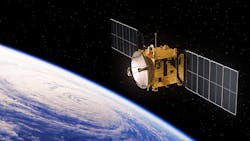There's never been a better time to be in the space electronics market
THE MIL & AERO COMMENTARY – The space electronics market is hotter than it's been in quite a while, and the real action is happening in low-Earth orbit where companies are offering opportunities for relatively small and inexpensive satellites with communications, sensing, and navigation payloads.
Most people involved in space electronics have known this for a while, yet a couple of developments in late May are driving home the importance of space operations in LEO for applications that are nearly pushing aside more traditional satellite uses in higher orbits.
First, the U.S. Air Force is reaching out to industry for ideas on new enabling technologies, materials, and manufacturing processes for next-generation large constellations of low-Earth orbit (LEO) military satellites.
Space electronics experts at the Air Force Research Laboratory at Wright-Patterson Air Force Base, Ohio, released a request for information on 29 May (FA8650-19-S-5021) for the Low-Cost Space Systems project, which seeks to use relatively high-risk commercial off-the-shelf (COTS) electronics technologies with relaxed space qualification requirements and radiation hardening in next-generation satellite buses and payloads with limited life cycles.
Current demand for LEO satellites indicates the need for greater responsiveness, lower cost, and new and disruptive spacecraft technologies for these kinds of space satellites, researchers say.
From industry, Air Force officials want new ways for spacecraft designers to reduce costs and build capable satellites with limited life cycles using relatively high-risk commercially technologies. In particular, researchers are interested in automation; state-of-the-art manufacturing techniques; standards and modularity; and non-traditional suppliers, materials, and space-qualification techniques.
It's clear that expensive space qualified components are yesterday's news when it comes to the new hot space market in LEO. Traditional space electronics suppliers are taking a cautious approach out of concern that the LEO market is moving so quickly that projects in higher orbits could become obsolete virtually overnight.
Systems integrators of satellites designed to operate at high altitudes like geosynchronous orbit are worried that their chief enabling technologies, often involving radiation-hardened components and radiation shielding, could diminish in importance as efforts center on small, inexpensive LEO satellites.
One big project confirming many of their fears is the Blackjack program of the U.S. Defense Advanced Research Projects Agency (DARPA) in Arlington, Va. Blackjack seeks to orbit a constellation of small, secure, and affordable military satellites that capitalize on modern commercial satellite technologies.
DARPA released a solicitation on 24 May that asks industry to find new ways of mixing and matching commercial satellite buses and military satellite communications (SATCOM) and reconnaissance payloads as late in the design process as possible.
DARPA officials want contractors to enable the Blackjack architecture to integrate several types of commercial satellite buses easily with a wide range of military payloads that involve not only SATCOM, but also sensors able to detect, identify, and track advanced missile threats; provide positioning, navigation, and timing (PNT); and provide space-based surface moving target indication.
Do we need any more evidence that large and expensive military GEO satellites already have seen their best days?
The advantages of moving military reconnaissance, communications, and positioning satellites to lower-Earth orbits have been known for a long time: the ability to use best-of-breed commercial-grade electronics; quick and easy technology insertion; limited satellite life cycles to accommodate new technologies quickly; and the ability to use on-orbit spares to compensate quickly for spacecraft failures.
Now military experts are trying to push those advantage. Are specially designed radiation-hardened electronic components necessary at all for satellites that will operate only for a few years? The near future will give us deeper and more important data on this question than we've ever had before.
Do we even need big expensive military GEO satellites anymore? Maybe, but time will tell if we can get by with a lot fewer of them. There has not been a better time to be in the space business perhaps since the Apollo program half a century ago.

John Keller | Editor-in-Chief
John Keller is the Editor-in-Chief, Military & Aerospace Electronics Magazine--provides extensive coverage and analysis of enabling electronics and optoelectronic technologies in military, space and commercial aviation applications. John has been a member of the Military & Aerospace Electronics staff since 1989 and chief editor since 1995.

